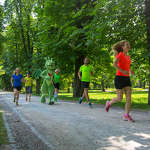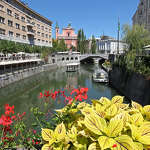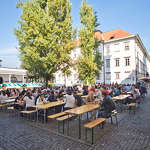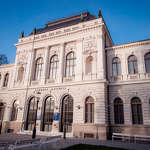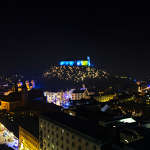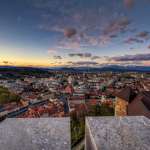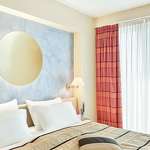
The Slovenian Capital - Ljubljana
Ljubljana is a green capital of a green country. Its image was forged by a thousand year-long history that goes back to the Roman times. Its current romantic image was for the most part designed by one of the greatest architects in the world – Jože Plečnik. Picturesque bridges and the central covered market are the heart of the city, while the hilltop castle has been guarding the city against modern influences for a century. Numerous travellers and celebrities have recognised the charms and attraction of one of the most beautiful cities in Europe.
OVERVIEW
DAY 1:
You will start your walk through the city in the very centre where three bridges work in concert to give the city that special feel and appearance. The statue of Slovenia's biggest poet, France Prešeren, is loved by the locals as a meeting place and starting point for errands or for a fun night out on the town. We will continue our walk to the Robba Fountain, past the Ljubljana Cathedral to Plečnik's Central Market and walk to the funicular railway that will take us up to the Ljubljana Castle that has watched over the city for more than 900 years. The castle offers amazing vistas over the city and its surroundings, and in clear weather even views of the nearby mountains. After sightseeing, you will descend into the city centre and take a short break in one of the many bars and restaurants, after which you can visit the National Gallery to see nearly 600 works of Slovenian and European artists. After satisfying your artistic hunger, you will quench your actual hunger by joining the Food Tour and delve into the culinary image of Slovenia. Accommodation and overnight stay in a hotel.
DAY 2:
The morning is reserved for your encounters with the biggest Slovenian architect, Jože Plečnik. The Plečnik House presents the architect's preserved home with all of the original interior and exterior furnishings as well as a permanent museum exhibition where you will learn about the architect's body of work and his life's journey. The central point of the exhibition presents the architect's creations in Ljubljana where he returned in 1921 following his resounding successes in Vienna where he created several pioneering pieces of modern architecture and in Prague where he transformed the famous castle into the president's residence. After lunch, you will board a boat on the Ljubljanica River and experience the city centre with prominent bridges, picturesque facades and river banks from a different perspective. The boat will take you on a circular tour featuring Plečnik's Sluice Gate and the Špica hang out spot on the river embankment. To finish off your experience of Ljubljana and wind down, you will walk to the beautiful Tivoli Park.
PACKAGE PRICE PER PERSON
- Individually, with own transport: from 179 €
- VIP package with a guide and transportation: from 265 €
- Group trip: from 192 €
THE ADVENTURE/PACKAGE INCLUDES
- Sightseeing in Ljubljana Centre
- Visit to the Ljubljana Castle by funicular railway
- Ljubljana Food-Tour
- Visit to the Plečnik House Museum
- Boat Cruise
- 1 x overnight stay with breakfast at the hotel ****
For more information about trips and activities click here.
ADDITIONAL INFORMATION
- the program is available and runs from 1 April to 31 October, arrivals are possible every day of the week
- the program is intended for individual passengers, groups of 2–7 persons and larger groups for which the program can be adapted
- possibility to combine two or more packages
- tourist tax is included in the price
Austria Trend Hotel Ljubljana ****
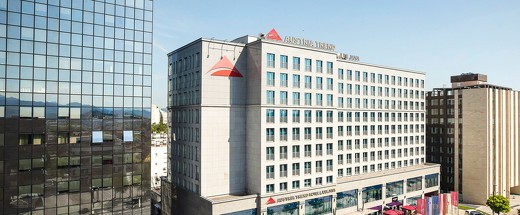
Austria Trend Hotel Ljubljana has an excellent location. The old city centre, the Gospodarsko razstavišče Exhibition and Convention Centre, the BTC shopping centre, the Krvavec ski resort and several golf courses are all located not far from the hotel. The main attractions and the centre of Ljubljana are easily accessible by public transport, and the hotel taxi can take you free of charge to the city centre. Maribor is 130 km away.
The hotel is an ideal vantage point for visiting the capital either on business or a starting point for a relaxed weekend in the Green Capital of Europe 2016. The hotel is considered to be one of the most modern city hotels with an international vibe. The hotel operates the Marco Polo à la carte restaurant with a winebar, several conference halls and state-of-the-art Gym 24 fitness facility (open 24/7) where the latest equipment is complemented with an extensive range of guided exercises and a sports clinic.
Austria Trend Hotel Ljubljana has 214 rooms that are very spacious, modern and bright. All rooms are air conditioned and feature an LCD TV, mini bar and free WiFi.
You will start your day here with an opulent self-service Morgenstund breakfast featuring regional delicacies and the option of choosing dietary or ecologically produced food.
Ljubljana
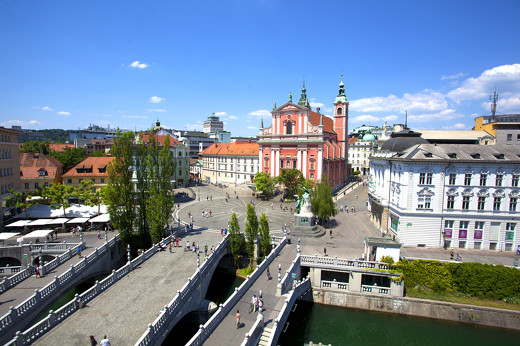
Both its residents and numerous visitors perceive Ljubljana as a city built on a human scale. Despite the fact that it ranks among the mid-sized European cities, it has preserved its small-town friendliness and, at the same time, it has everything that all the larger capitals have. In the winter its dreamy central European character prevails, while the summer brings out its relaxed Mediterranean feel.
Top seven reasons to visit Ljubljana:
1. Ljubljana is considered to be the hidden gem of Europe
Numerous visitors describe Ljubljana as a hidden gem of Europe. Its picturesque image has been marked by different historical periods, and mostly by the opus of the world-famous architect, Jože Plečnik. Discover the city's main attractions and use the Ljubljana Card to get a range of discounts when you visit them.
2. Ljubljana is a city with a green soul Ljubljana, the European Green Capital 2016, is a city with a green soul and a sustainable vision of development. It boasts excellently preserved green spaces and nature even in the heart of the city centre. It also offers several experiences that are difficult to imagine anywhere else. Explore the city by bike or by Segway and discover its centre from the unique perspective of a paddle-board on the Ljubljanica River.
3. Treat yourselves to a romantic getaway Ljubljana has love written in its name, which sounds similar to the Slovenian word “ljubljena” (beloved). The soul of the city is the Ljubljanica River, crossed by picturesque bridges. People still take time to sit in the outdoor cafés. The picturesque scene for your experiences is complemented by the ancient castle reigning on the hill above Ljubljana, the city’s symbolic dragons, and numerous romantic stories.
4. Enjoy the local cuisine In recent years, Ljubljana has experienced a true culinary boom. Visit the Open Kitchen (Odprta kuhna) to feel its lively pulse. Renowned master chefs, restaurants and local dishes from the Taste Ljubljana and Taste Central Slovenia projects are becoming increasingly recognised worldwide. The highest-rated restaurants, selected by local experts, can be identified by the Ljubljana Quality Mark they display.
5. A lively cultural capital with numerous interesting festivals Ljubljana is a creative city, where culture is basically the way of life. It hosts numerous festivals of various genres, from one of the oldest European summer festivals to well-established festivals of jazz, world music and street theatre. There are also numerous alternative events, particularly at the famous Metelkova alternative culture centre.
6) Discover Central Slovenia When visiting Ljubljana, don't just enjoy the city. Go off the beaten path and experience the real Slovenia. The area surrounding Ljubljana or various locations in the Central Slovenia region are the right choice for a relaxed and active vacation in a pleasant natural environment.
7) Experience Slovenia on daily trips from Ljubljana Ljubljana is the best starting point to explore Slovenia. On our website you can book several day trips with transfers from Ljubljana. Visit the country's most famous attractions such as Bled and the Postojna Cave, discover natural beauty or join in with unforgettable organized experiences.
Basic information on Ljubljana
The capital of the Republic of Slovenia (Slovenia has been a European Union member since 2004.)
Area: 275 km²
Population: 283,000
Average temperature in January: - 0.3 °C
Average temperature in June: 20.7 °C
Ljubljana Castle
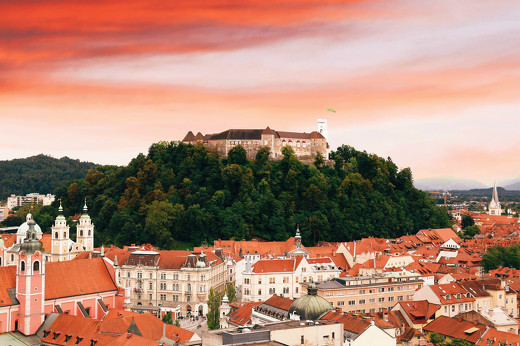
Ljubljana Castle, standing on a hill above the city for about 900 years, is Ljubljana's main attraction. The castle's Outlook Tower and ramparts offer some of the most beautiful views of the city, while the castle houses a museum exhibition on Slovenian history, a puppet museum, and a number of historical rooms such as the Chapel of St George, the Prison, and a video presentation room called Virtual Castle.
Ljubljana Castle, which can quickly be reached by funicular railway, also provides space for art exhibitions, houses a café, a nightclub, and two restaurants (Strelec and Gostilna na Gradu), and serves as a venue for cultural events, family entertainment, dance evenings, and open-air film screenings held under the title of Film under the Stars in the summer.
Outlook Tower
Ljubljana Castle's Outlook Tower offers the most beautiful views of Ljubljana and its surrounding areas. It stands on a site originally occupied by the Pipers' Tower, which was pulled down in 1813 following the French occupation, and later by a fire lookout tower, home of the city's fire watchman.
The exhibition Slovenian History
The exhibition, divided into six sections, covers the entire known history of Slovenia. It takes you back about 200,000 years in history, to the earliest traces of human presence in the area of present-day Slovenia.
Puppet Museum
Slovenia is a country with a rich tradition of puppeteering. This permanent museum exhibition set up by the Ljubljana Puppet Theatre introduces you to the history of puppeteering in Slovenia and the creativity of contemporary Slovenian puppeteers.
National Gallery
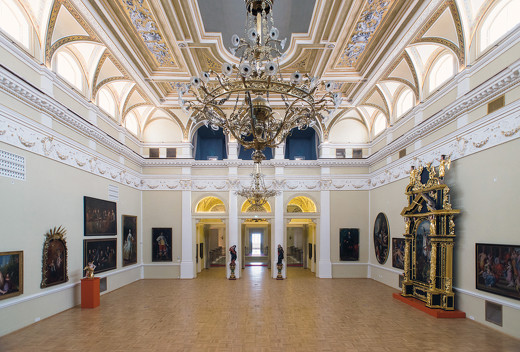
The National Gallery, Slovenia's foremost museum of historical art, holds the country's largest collection of fine art from the High Middle Ages to the 20th century. It also houses a permanent exhibition of works by Zoran Mušič (1909–2005), one of Europe's leading modernist painters, and various temporary exhibitions.
The National Gallery's permanent collection, divided into sections according to historical periods, is comprised of nearly 600 works by Slovenian and European artists. Among other things, it includes medieval sacred art, works of art by the Baroque artists Gregorio Lazzarini in Giulio Quaglio, Biedermeier portraits by Jožef Tominc, neoclassical paintings by Franc Kavčič, works by the Realists Janez Šubic and Jurij Šubic, paintings by the popular Slovenian painter Ivana Kobilca, and the famous masterpieces of Slovenian Impressionism created by Ivan Grohar, Rihard Jakopič, and Matija Jama.
The gallery also keeps one of the largest pieces of Baroque art in Ljubljana, the Fountain of Three Carniolan Rivers by Francesco Robba, whose original site in front of the Town Hall is now occupied by its replica.
Apart from the above, the National Gallery houses a room called Gal's Room, where children's and family events are held on a regular basis, an extensive library, a gallery shop with a reading corner, and a café.
Food Tour
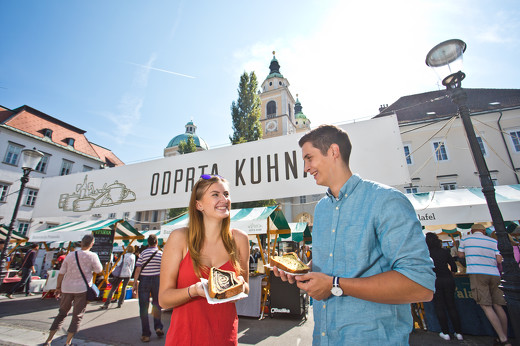
The tour will give you an insight into traditional Ljubljana dishes, which are today mostly prepared using modern cooking methods and have recently been given a new life as part of the much-acclaimed Taste Ljubljana project. You will visit five different styles of restaurants and taste five different dishes as well as five selected drinks.
Today, traditional Ljubljana food and drinks are coming alive in widely differing ways, for which reason the tour will take you to a street food outlet, a traditional 'gostilna' restaurant with a historical concept, a modern restaurant, another modern restaurant, this one following the model of socially responsible entrepreneurship and a catering outlet located at a popular lookout point. To learn about Ljubljana dishes' locally sourced ingredients, you will also visit the Ljubljana Central Market and the vegetable gardens located in the Krakovo area of Ljubljana.
Plečnik House
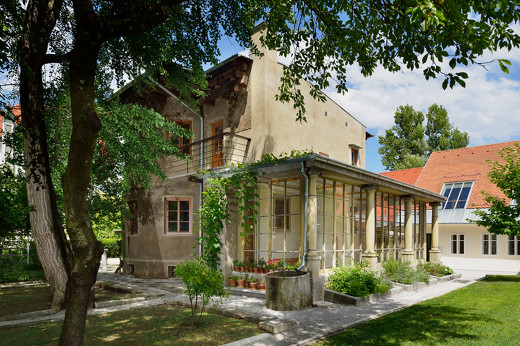
Get to know the life and work of the famous architect Jože Plečnik, who left an indelible mark on the cityscape of Ljubljana. At Plečnik House you can see the architect's home exactly as it was in his lifetime and view a permanent exhibition showcasing his work.
Permanent Exhibition 'Plečnik'
The exhibition gives you an insight into Plečnik's life and work, focusing particularly on the architect's creations in Ljubljana, where he returned in 1921 following a successful career abroad, first in Vienna, where he created a number of pioneering works of modern architecture, and then in Prague, where, among other things, he renovated Prague Castle after it had become the official residence of the Czechoslovak president.
The exhibition brings together not only sketches, plans, models, and photographs relating to Plečnik's famous creations such as the National and University Library in Ljubljana, the Ljubljana Central Market, and the Church of St Michael in the Marshes, but also plans for buildings that never saw the light of day, the most notable being the Cathedral of Freedom, intended to house the Slovenian Parliament.
Plečnik House complex
Plečnik House comprises a complex of two neighbouring houses and an adjacent garden with a lapidary, which, along with Plečnik's original furniture, library, drawing tools, personal belongings, and a large archive of sketches, plans, photographs, and models all form part of the Plečnik Collection.
One of the two houses within the complex was bought by the architect's brother Andrej in 1915. When Plečnik returned to Ljubljana in 1921, he and his two brothers and a sister decided to live together, so the architect built a cylindrical annexe to the house (1925). Later he added a glassed porch and, after purchasing an older suburban house next door, a conservatory (1930). Despite the agreement between the siblings to live together, only the architect's brother Janez lived in the house for a while. When he moved out, Plečnik refurbished the house to make it suit his own requirements. The refurbishment and extension works to the two houses were often done using leftover materials from Plečnik's other projects.
About Jože Plečnik
The architect Jože Plečnik (1872-1957) came a long way from being an apprentice at his father Andrej's cabinet-making workshop to becoming a highly regarded architect, a well-respected professor at the Ljubljana Faculty of Architecture, and the recipient of numerous national and international accolades. His visionariness and original approaches continue to inspire architects and architecture enthusiasts around the world.
Boat Cruise
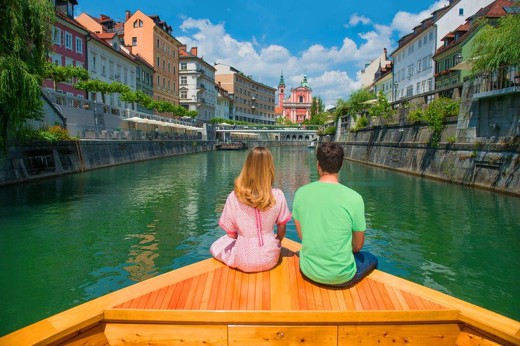
The tour, beginning in front of the Town Hall, takes you through the historical city centre, whose unique architecture is the legacy of the Baroque and Art Nouveau periods and, most notably, the work of the famous 20th century architect Jože Plečnik. The tour includes a stop at one of Ljubljana's restaurants, where you will have an opportunity to taste traditional Slovenian dishes as part of a brief tasting session.
Tourist boats on the river Ljubljanica provide an opportunity to experience the old city centre's picturesque bridges, façades, and embankments from a completely different perspective. On this tour, a boat will take you on a circular cruise between the famous Plečnik's Ljubljanica Sluice Gate and the Špica embankment.
The Tivoli Park
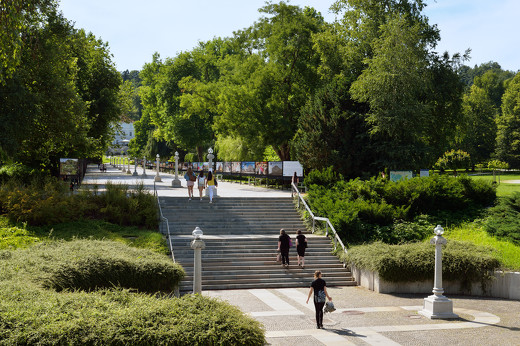
Tivoli Park is Ljubljana's largest and most beautiful park, stretching right into the city centre. It was designed in 1813 by the French engineer Jean Blanchard and created by joining together the parks which had surrounded Podturn and Cekin Mansions. The park, covering an area of approximately five square kilometres, is crossed by three grand horse chestnut tree-lined walks and landscaped with ornamental flower beds, interesting trees and numerous statues and fountains. The park area blends into the slopes of the Rožnik hill, to which it is connected by several walking paths and a trim trail with several exercise stations along its length.
Jakopič Promenade, a popular outdoor gallery
Tivoli Park's scenic Jakopič Promenade (Jakopičevo sprehajališče), designed by the architect Jože Plečnik in the central part of Tivoli Park, has become a well known outdoor venue for exhibitions of large-format photographs, open throughout the year.
Location details
Since its general layout was made in 1813, Tivoli Park has seen several expansions and re-landscaping projects, including the building of a fish pond on its western edge in 1880. Next to the pond there is a small botanical garden with a glasshouse, whose management was entrusted to the Ljubljana Botanic Garden on its 200th anniversary in 2010. The glasshouse houses a permanent exhibition of tropical and carnivorous plants. Across the way from the fish pond, a children's playground was built in 1942 and refurbished with new play equipment in 1994.
Between 1921 and 1939, an extensive re-design project was undertaken by the architect Jože Plečnik, who designed the park's wide Jakopič Promenade, which ends at the bottom of the stairway leading to Tivoli Mansion. The promenade is named after the Slovenian Impressionist painter Rihard Jakopič.
In 1929, the Letno Kopališče Ilirija outdoor swimming pool was built at the edge of the Tivoli park to a design by Stanko Bloudek. At the time when it was built it was the most modern swimming pool in the Kingdom of Yugoslavia. In memory of Bloudek, a sports park bearing his name was later built in front of the Tivoli park's Cekin Mansion (Cekinov grad). It included tennis and basketball courts, a roller-skating rink and a children's playground designed by the architect Marjan Božič. In 1965, Božič also designed Dvorana Tivoli, a hall intended for sports events and larger concerts. Not far away, a sports and recreational centre with an indoor swimming pool, fitness facilities and a bowling alley was built to a design by Fedja Košir in 1973.
- H1 Austria Trend Hotel Ljubljana ****
- 2 Ljubljana
- 3 Ljubljana Castle
- 4 National Gallery
- 5 Food Tour
- 6 Plečnik House
- 7 Boat Cruise
- 8 The Tivoli Park
-
- VIP tour with tourist guide and transportation
- Group trip
-
No. of peopleConfirm
Transfer from the airport
Guests arriving by air will be offered comfortable transfers at competitive prices from close by airports. Our chauffeur will meet you at the arrival and will bring you back safely and on time
to the airport at the departure. You can cancel the transfer from your home to the hotel without expenses within 72 hours prior to scheduled transfer. You will receive the information about the exact time of departure a day before the scheduled transfer.
-
From - to:
-
Distance:km
-
Travel time:h
-
Type of transfer:One-way transfer
-
Price:€ per person
-
Number of people:
-
From - to:
-
Distance:km
-
Travel time:h
-
Type of transfer:Return transfer
-
Price:€ per person
-
Number of people:
Transfer from home to the hotel
Guests from northern Italy are offered the possibility of transport from home to the hotel. You can choose between
morning or afternoon directory term, the carriage is available for 2-7 passengers, reservation up to 5 days prior to departure. The notice of the exact time and location of departure one day prior to the tour.
-
From - to:BENETKE - MORAVSKE TOPLICE
-
Distance:km
-
Travel time:h
-
Type of transfer:One-way transfer
-
Price:€ per person
-
Number of people:
-
From - to:BENETKE - MORAVSKE TOPLICE
-
Distance:550 km
-
Travel time:5,5h
-
Type of transfer:Return transfer
-
Price:€ per person
-
Number of people:
Holidays in Slovenia portal.
You will receive an automatic reservation recapitulation on your e-mail address,
final confirmation will be sent upon payment.
You will receive an update on your reservation within 2 hours; if not, please, call us as soon as possible or send e-mail. Also check SPAM.
Thank you for your confidence and best regards.
HolidaysinSlovenia.eu






